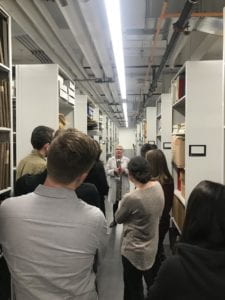In “Introduction to Archives,” APH students are exposed to important archival themes such as arrangement & description, accessioning/processing collections, preservation, and much more. It is a vital and fundamental course for students planning to pursue a career in archives.
 Towards the end of the Fall 2018 semester, students from the “Introduction to Archives” class were lucky enough to get a private tour of the Fashion Institute of Technology’s newly renovated archive. Not only was this behind-the-scenes tour a treat because students would have access to a truly unique and rich archive, but also, this tour allowed APH students to take the knowledge they’ve acquired over the course of the semester and see it applied in an actual archive setting. The tour was led by Karen Trivette, the Associate Professor-Librarian, Head of Special Collections & College Archives at FIT.
Towards the end of the Fall 2018 semester, students from the “Introduction to Archives” class were lucky enough to get a private tour of the Fashion Institute of Technology’s newly renovated archive. Not only was this behind-the-scenes tour a treat because students would have access to a truly unique and rich archive, but also, this tour allowed APH students to take the knowledge they’ve acquired over the course of the semester and see it applied in an actual archive setting. The tour was led by Karen Trivette, the Associate Professor-Librarian, Head of Special Collections & College Archives at FIT.
A quick background on FIT. To quote the FIT website, the FIT Special Collections & College Archives is a “highly-specialized repository and rich resource for the fashion industry and scholars of design history, including FIT’s own fashion-centric graduate and undergraduate programs.” FIT’s archive recently completed a 4 million dollar renovation, expanding in size from 3,500 square feet to 6,100 square feet.
The “Introduction to Archives” students were privileged enough to be given access to FIT’s two climate-controlled storage rooms filled with archival materials, they got to learn about the archival techniques used within FIT’s archive (categorization/organization methods, preservation methods, research, etc..), they learned about the archive’s online database and finding aids, the archive’s protocols with regards to researchers, and they also got to view/handle original Chanel and Dior fashion sketches.
It was an educational class trip and the students had a great time. A big thank you to Karen and the FIT College Archives & Special Collections for hosting us! Karen was so gracious, enthusiastic, and she did a wonderful job answering the students’ questions about the FIT Archives, as well as archiving in general.